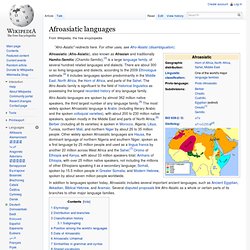

Dravidian languages. Tibeto-Burman languages. The Tibeto-Burman languages are the non-Sinitic members of the Sino-Tibetan language family, over 400 of which are spoken throughout the highlands of southeast Asia, as well as lowland areas in Burma (Myanmar). The name derives from the most widely spoken of these languages, namely Burmese (over 32 million speakers) and the Tibetic languages (over 8 million). Most of the other languages are spoken by much smaller communities, and many of them have not been described in detail. Some taxonomies divide Sino-Tibetan into Sinitic and Tibeto-Burman branches (e.g. Benedict, Matisoff). Afroasiatic languages. Afroasiatic (Afro-Asiatic), also known as Afrasian and traditionally Hamito-Semitic (Chamito-Semitic),[3] is a large language family, of several hundred related languages and dialects.

There are about 300 or so living languages and dialects, according to the 2009 Ethnologue estimate.[4] It includes languages spoken predominantly in the Middle East, North Africa, the Horn of Africa, and parts of the Sahel. The Afro-Asiatic family is significant to the field of historical linguistics as possessing the longest recorded history of any language family.